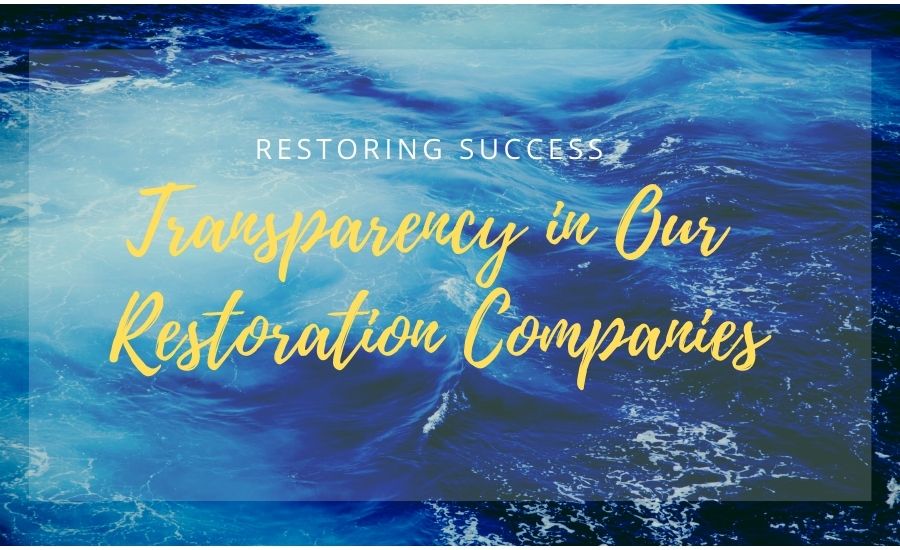Last month’s Restoring Success, Morale and Engagement Built on a Foundation of Trust, we explored the importance of trust and the leadership role in fostering a culture of positive morale and engagement. Stephen Covey's Speed of Trust presents 13 key behaviors that are instrumental to us as individuals and leaders in building and fostering trust. One of these behaviors is to create transparency:
Behavior #3: Create Transparency
Be real and genuine and tell the truth in a way that people can verify. The opposite is to obscure, and the counterfeit is an illusion of pretending things are different than they are. You can establish trust quickly by being open and authentic, erring on the side of disclosure and not having hidden agendas.”
Transparency is a broad concept and behavior in which some may struggle on finding the right and appropriate level of in their organization. As a side note, I firmly believe that this behavior and competency is most important in positively leading the team through 2020, the pandemic, and the continuous challenges. Metrics seem to be a common area where the best-intentioned of leaders have concerns. It is important to consider that not demonstrating the appropriate level of transparency, even with numbers, can have a detrimental unintended consequence.
A few considerations:
- Trust: If we agree with Covey, that transparency is a key behavior of trust and that it is the leader’s job to extend trust first; we are behaving contrary to building the foundation of trust when we are not transparent.
- Accountability: It is difficult to hold others accountable without giving them access to the appropriate information.
- Open and Constructive Feedback: Transparency is a key behavior to have a culture that embraces open and constructive feedback on job and company performance in the spirit of continuous improvement.
After a great conversation about trust and transparency with a restoration company leader and friend, I asked her to share her thoughts and perspective.
Chelsea Mihalko Trimbath presents the following on trust in our restoration companies and being transparent with numbers:
What do most relationships thrive on? What drives loyalty? What is stability built on? The answer is TRUST. Stability, honesty, loyalty, drive and motivation are all qualities managers wish to see in their employees. These qualities do not necessarily exist or at their peak on the first day with a company. If we are lucky, after years of service, these qualities develop, and the relationship built on trust grows.
Our goal as leaders should be to build trust with our employees, to show that not only do we trust them and that they can trust us, but also, that we are dedicated to seeing them excel in every aspect of their life. One way to accomplish this type of relationship building is through transparency. Now wait, before you roll your eyes, let’s dig deeper.
Transparency comes in all different forms at all different levels. We cannot expect some of the people in our organizations to understand what overhead consists of just as we cannot expect some people to understand how to perfectly install a wood floor. Members of the team contribute to the organization in a variety of unique ways but leading someone blindly is a path to failure. Failure not only showing in your bottom line, but also, failing the individuals by not motivating or giving clear objectives. Transparency can be instrumental in engaging and holding the team accountable.
As a leader of an organization, it’s our job to know the direction of the company and have clear goals along the way. Members of the team should have clarity of objectives and transparency in information necessary to reach and manage their individuals and company goals.
Many goals, quotas or milestones are measured in numbers in our business.
- Labor Hours: Increase productivity through responsibility by being transparent.
Labor hour goals are simple numerical goals that can be conveyed throughout the organization. If a certain task should take 5 hours to complete to hit average profit goals, we can set the expectation as 5 hours. A motivated and skilled employee that can finish the job in 3 hours can still be motivated by the 5-hour max and enjoy the satisfaction of beating the goal and potentially increasing his value to the organization. Being transparent with the allowed maximum hours gives individuals the opportunity to apply themselves and work towards the goal and potentially create drive and innovation to complete the work in the most efficient and effective way possible. Providing employees with the opportunity and information to make decisions that impact themselves and the company cultivates trust.
- Employee Cost – Build relationships through genuine understanding
Have you ever had someone come and ask for a raise that was just given an extra week of vacation and the latest new model iPhone? Does that person truly know what they cost the company? Do you really know what that person values as an employee? Another opportunity for transparency! An employee should know and understand the value of what they are being paid including their wage, benefits and perks, including but not limited to: vacation, health insurance, retirement, life insurance, phone, vehicle (including gas allowances and insurance), computer, etc. Educating the team and being transparent regarding the costs of things can create a better platform for open discussions. For example, during a performance review, there may be an opportunity to learn that someone highly values their family time and prefers additional vacation days rather than a monetary raise. These meaningful conversations will help build a culture of trust and a depth of care from management.
- Overall Profits – Increase innovation and motivation
This one is scary for a lot of business owners. They want to keep their numbers under tight wraps and closed away for only their eyes. But going back to the above point, how can we expect our managers to hit company goals without giving them all the information to get there? Direct project managers will be better able to control their jobs if they have access to job profitability numbers, budgets and goals. They will be more equipped to negotiate material pricing, providing budget selections and understanding labor hours to meet profitability goals. Transparency on labor hours inflated costs (per hour cost per employee + benefits) so they are better able to choose who will do the best trade on each job. Transparency to our estimators and project managers about the cost per lead (marketing), any software or management fees per job (overhead). If owners plan to place high standards on their managers, the managers will perform better with a general understanding of business operations and costs. And while owners may choose to keep certain numbers under wraps, profits, expenses and overhead per job should be direct and easily accessible so managers can be checking in constantly. Providing this open communication will foster innovation and allow for more creative flows to happen. Mangers will feel empowered knowing they have the authority to make decisions that directly affect them and the company, their confidence and motivation will grow along with the numbers.
Regardless on your position about transparency, it is an important behavior to reflect upon and consider. For many reasons, it may be one of the most difficult behaviors as a leader and one that causes concern or fear. If you have a sense that being more transparent can help foster trust and a positive culture, take one small step at a time.


